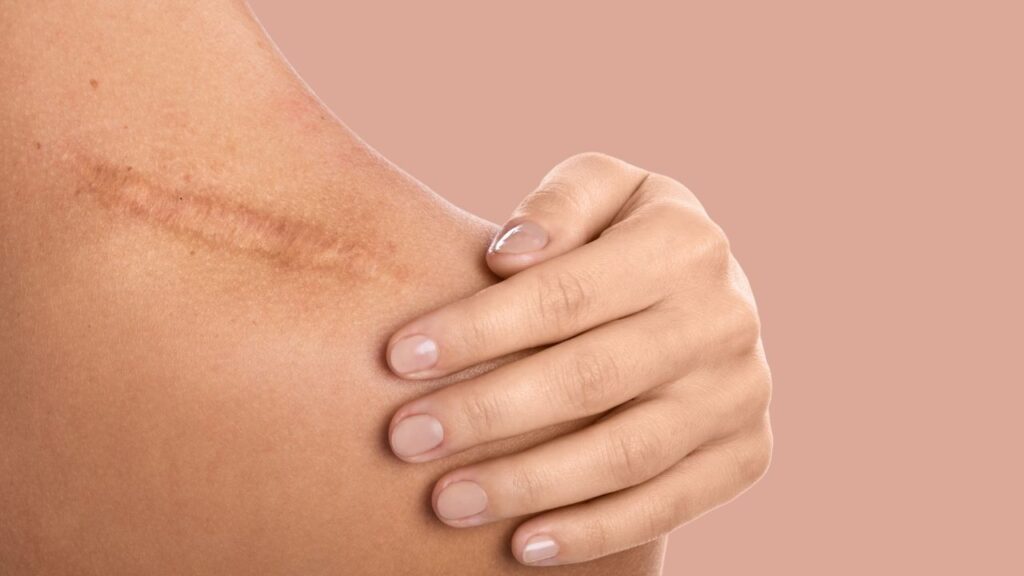Table of Contents
Overview
Unwanted changes in skin colour or discolouration are symptoms of pigmentation. It’s a broad phrase for darkening or lightening areas of skin or for having an uneven skin tone.
Melanocytes are the cells that produce melanin, a pigment that gives colour to the skin. The level of pigmentation may be determined by a person’s genetic buildup or by a range of environmental variables affecting the body’s ability to produce melanin.
Melanin production is raised when melanocytes are damaged. When skin sections are darker than the rest, it’s called hyperpigmentation. Deposition of excessive melanin causes dark spots to appear on the face, neck, and corners of the lips. This excessive melanin forms clusters resulting in dark spots or hyperpigmentation. It may affect people of any age or skin type, although it’s typically considered harmless.
Melasma is a form of hyperpigmentation that affects millions of people every year. The most common melasma symptoms are blue-grey, brown, or black spots on the skin. You may also see them as flat patches or spots that look like freckles. Forearms and face, particularly the cheeks, upper lip, and forehead, are common sites of infection. The term “pregnancy mask” refers to melanomas often seen in pregnant women. Melasma deepens and lightens over a year, unlike other skin conditions.
How can you prevent hyperpigmentation and melasma?
Tips to Prevent Hyperpigmentation
- The best way to avoid hyperpigmentation is to use sunscreen every day. Apply 20 minutes before going outside.
- To protect your skin from the sun’s harmful rays, wear hats, sunglasses, scarves, and other protective apparel while you’re out in the open.
- Pay close attention to what you apply to your skin. Make use of a cleanser with salicylic acid and a gentle exfoliant (beta hydroxy acid). Use a good-quality moisturizer to keep your skin hydrated and prevent acne.
Prevention of Melasma
- When you’re out in the sun, wear a wide-brimmed hat and other protective apparel to keep your skin covered.
- Preventing too much exposure to UV rays is the most effective way to prevent melasma. For this, apply a broad-spectrum sunscreen with titanium dioxide or zinc oxide with an SPF of 30 or higher. Wear sunscreen every day, particularly while swimming or engaging in outdoor activities, to protect yourself from the sun’s harmful rays. For best results, apply sunblock every two hours.
- For hair removal, avoid waxing at all costs. Waxing may irritate the skin and exacerbate the symptoms of melasma. If you’re concerned about the safety of laser hair removal, consult with your dermatologist.
- Avoid using topical skincare products such as light soaps, shower gels and lotions, which cause skin irritation. Only use those skincare products that are non-comedogenic and non-irritating. Anything that hurts or irritates your skin will only exacerbate your melasma.
Difference between Hyperpigmentation, and Melasma
Hyperpigmentation: Hyperpigmentation is a common disorder that alters skin colour, resulting in discoloured spots or discolouration patches. Various reasons, such as UV damage, acne scars, and inflammation can cause it leftover after an eczema flare-up.
Melasma: It is a form of hyperpigmentation in which brown or blue-grey patches form on the skin. Women are more likely to suffer from melasma, which commonly affects the forehead, chin, and upper lip. Melasma is caused by UV rays along with hormonal changes.
The importance of sun protection
Conditions like melasma and post-inflammatory hyperpigmentation(PIH) are worsened by ultraviolet (UV) radiation and visible light exposure. Thus, sunscreen is a must. Even those with photo-exacerbated disorders, individuals with darker skin are less likely to wear protective clothing or apply sunblock. Sunscreens provide broad-spectrum protection from the sun’s rays, UVA, UVB, and visible light. It helps stabilise and improve pigmentation issues in people with darker skin.
The latest treatment for hyperpigmentation and melasma
- Azelaic acid can be used twice a day as a lotion, cream, or gel-like cream. It is advised to use this product after a doctor’s consultation.
- Hydroquinone: is applied topically as lotion or cream directly to the melasma patches at night for two to four months.
- Kojic Acid: Naturally occurring in fungi, kojic acid lightens the skin. It prevents the synthesis of the amino acid tyrosine, which is necessary for melanin production.
- Chemical Peels: in chemical peeling, the top most layer of the skin is removed with a chemical agent. Glycolic acid (alpha hydroxy acid) and lactic acid exfoliate the skin’s surface and remove hyperpigmented areas or dark skin spots, allowing new skin cells to rise to the surface.
- Laser Therapy: Consider laser resurfacing if your hyperpigmentation is severe. In this, the epidermal layers of the skin are removed using focused light beams. Consult a skin doctor to see whether your skin can tolerate this kind of laser treatment.
Conclusion
Suppose you’re conscious of having any skin conditions that may affect your social life, then you should take steps to get rid of these skin issues and prevent them in the future. We have a top-notch dermatologist on staff to assist you with your problem. Please make an appointment with one of our specialists to discuss your issues and ask your questions.





